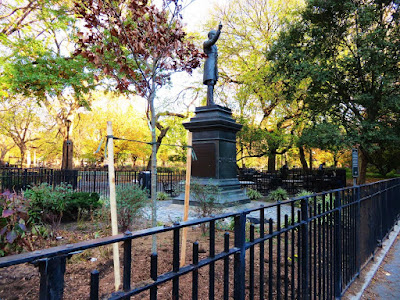Photo by Derek Berg
Wash day for the Samuel S. Cox statue at the Seventh and A entrance to Tompkins Square Park...


Historians and numerous New Yorkers have highlighted that Cox’s history — beyond his work regarding pro-labor policies at the United States Postal Service — includes very disturbing examples of white supremacy, particularly as it relates to emancipation and Black civic participation in the mid-1800s.
Today’s demands for social justice that are being raised across this country must be met with a holistic review of the (mostly) men whom we honor with place names and statues in our public spaces.
I am sure most New Yorkers would agree that these landmarks should not remain as a public reminder to many of our neighbors that, for much of United States history, they were not considered nor treated as equals to white Americans. As many historians have suggested, such statuary is better situated in non-public settings, such as museums, where they can remain as an educational tool for future generations choosing – operative word — to view and understand our nation’s racist legacy. Encountering the Cox statue while visiting Tompkins Square Park is not a choice.
I hope that you will consider speaking with the local community immediately, specifically Black residents of the Lower East Side, to consult with them on the Cox statue’s fate.






After the statue’s unveiling on Independence Day 1891, the New York Tribune noted, somewhat less charitably, that Cox’s “usually genial countenance is strained” and “out of harmony” with the Congressman’s natural demeanor. “The likeness is not a good one, and the facial resemblance is hardly suggestive,” the article added. A New York Times account of the ceremony questioned whether the statue “will ever be greatly admired as a work of art.” Nevertheless, a reported 2,500 letter carriers came from as far away as New Orleans and Memphis to participate in the moving ceremony to honor Cox at the statue’s unveiling.
The statue originally stood near Cox’s home on East 12th Street at the intersection of Lafayette Street, Fourth Avenue, and Astor Place. In November 1924, due to a street-widening project in the vicinity of Astor Place, it was moved to its current location at the southwest corner of Tompkins Square Park.

He was a backer of the Life Saving Service, later merged into the United States Coast Guard. He was also known as the "letter carriers' friend" because of his support for paid benefits and a 40-hour work week for U.S. Post Office employees. In gratitude, postal workers raised $10,000 in 1891 to erect a statue to Cox in Tompkins Square Park in New York.


Samuel Sullivan “Sunset” Cox (1824–1889) was born in Zanesville, Ohio, and served his home state as a Democratic Congressional representative from 1857 to 1865 before being unseated. After moving to New York in 1866, Cox served again in Congress for several terms from 1869 until 1889.
Although Cox once publicly declared that his most satisfying contribution to public service was championing the Life Saving Service—founded in the 1840s to patrol the coasts and save imperiled boaters during bad weather, the group was absorbed into the Coast Guard in 1915—this statue is sponsored by U.S. Postal Service workers because of Cox’s support for their quality-of-life issues. Known as the “letter-carriers’ friend,” Cox spearheaded legislation that led to paid benefits and a 40-hour workweek for postal employees. Mail carriers from the 188 cities named on the monument contributed $10,000 for the statue in a campaign that began soon after Cox’s death.
Sculptor Louise Lawson’s statue of Cox, unveiled in 1891, depicts him orating before Congress. Lawson (186?–1899) came from a prominent Ohio family. She and her brother, U.S. Representative W. D. Lawson, both attended Cox’s 1889 funeral at which President Grover Cleveland and General William Sherman served as honorary pallbearers. One might interpret the statue’s somewhat stiff quality as representative of Cox’s steadfast stance on issues for which he advocated.

Jack Kerouac wandering along East 7th street after visiting Burroughs at our pad, passing statue of Congressman Samuel "Sunset" Cox, "The Letter – Carrier's Friend" in Tompkins Square toward corner of Avenue A, Lower East Side; he's making a Dostoyevsky mad-face or Russian basso be-bop Om, first walking around the neighborhood, then involved with The Subterraneans, pencils & notebook in wool shirt-pockets, Fall 1953, Manhattan.